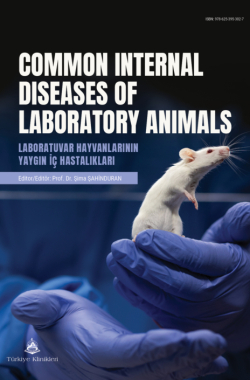Mouse Hepatitis Virus
Alanur BAKIRa , Ceren DİNLER AYa , Bülent ULUTAŞa
aAydın Adnan Menderes University Faculty of Veterinary Medicine, Department of Internal Medicine, Aydın, Türkiye
Bakır A, Dinler Ay C, Ulutaş B. Mouse hepatitis virus. In: Şahinduran Ş, ed. Common Internal Diseases of Laboratory Animals. 1st ed. Ankara: Türkiye Klinikleri; 2024. p.88-91.
ABSTRACT
Coronaviruses (CoV) pose a significant threat to laboratory animals and often lead to infectious colony-wide devastation. Among these, Mouse Hepatitis Virus (MHV) is a prominent example. The biological behavior of MHV isolates differs according to organ tropisms as enterotropic and polytropic. Enterotropic strains have selective tropism for the intestinal epithelium. They induce devastation in the newborn mouse population with 100% morbidity. Polytropic strains show primary tropism for the upper respiratory tract epithelium, also secondary tropism for various cells or tissues. These strains enter through the nasal route and disseminate throughout the body via viremia, affecting organs such as the lungs, liver, bone marrow, brain, lymphoid tissue, and reproductive organs. Clinical signs may remain elusive in immunocompetent mice. However, immunodeficient mice are susceptible to acute encephalomyelitis associated with polytropic strain. This chapter aims to convey information from current perspectives about MHV.
Keywords: Coronavirus; laboratory animals; mouse hepatitis virus
Kaynak Göster
Referanslar
- Müftüoğlu B, Albayrak H. Fare, Sıçan ve Tavşanların Viral Hastalıkları. Turk Vet J. 2019;1(2):84-9.
- Aydın H. Fare Hepatit Virusu (MHV) Üzerine Bir Derleme. Lab Hayv Bil & Uyg Derg. 2022;2(1):42-8.
- Homberger FR. Enterotropic mouse hepatitis virus. Lab Anim. 1997;31(2):97-115. [Crossref] [PubMed]
- Whary MT, Baumgarth N, Fox JG, Barthold SW. Chapter 3 - Biology and Diseases of Mice. In: Fox JG, Anderson LC, Otto GM, Pritchett-Corning KR, Whary MT, eds. Laboratory Animal Medicine. 3rd ed. Oxford, England: Elseiver; 2015. p. 43-149. [Crossref]
- Körner RW, Majjouti M, Alcazar MAA, Mahabir E. Of Mice and Men: The Coronavirus MHV and Mouse Models as a Translational Approach to Understand SARS-CoV-2. Viruses. 2020;12(8):880. [Crossref] [PubMed] [PMC]
- MacLachlan NJ, Dubovi EJ. Fenner's Veterinary Virology. Chapter 24-Coronaviridae. 5th ed. Hampshire, England: Elseiver; 2017. p. 435-61. [Crossref]
- Barthold SW, Smith AL, Lord PFS, Bhatt PN, Jacoby RO, Main AJ. Epizootic coronaviral typhlo-colitis in suckling mice. Laboratory Animal Science. 1982; 32:376-83.
- Ishida T, Taguchi F, Lee YS, Yamada A, Tamura T, Fujiwara K. Isolation of mouse hepatitis virus from infant mice with fatal diarrhea. Lab Anim Sci. 1978;28(3):269-76.
- Ishida T, Fujiwara K. Pathology of diarrhea due to mouse hepatitis virus in the infant mouse. Jpn J Exp Med. 1979;49(1):33-41.
- Barthold SW. Mouse hepatitis virus biology and epizootiology. In: Bhatt PN, Jacoby RO, Morse AC III, New AE, eds. Viral and Mycoplasmal Infection of Laboratory Rodents: Effects on Biomedical Research. Orlando: Academic Press; 1986. p. 571-601. [Crossref]
- Barthold SW, Smith AL, Povar ML. Enterotropic mouse hepatitis virus infection in nude mice. Lab Anim Sci. 1985;35(6):613-8.
- Barthold SW, Smith AL. Mouse hepatitis virus. In: Fox JG, Barthold SW, Davisson MT, Newcomer CE, Quimby F, Smith AL, eds. The Mouse in Biomedical Research. London: Elsevier; 2007. p. 141-78.
- Zuo J, Stohlman SA, Hoskin JB, Hinton DR, Atkinson R, Bergmann CC. Mouse hepatitis virus pathogenesis in the central nervous system is independent of IL-15 and natural killer cells. Virology. 2006;350(1):206-15. [Crossref] [PubMed] [PMC]
- Walsh KB, Edwards RA, Romero KM, Kotlajich MV, Stohlman SA, Lane TE. Expression of CXC chemokine ligand 10 from the mouse hepatitis virus genome results in protection from viral-induced neurological and liver disease. J Immunol. 2007;179(2):1155-65. [Crossref] [PubMed]
- Das Sarma J. A mechanism of virus-induced demyelination. Interdiscip Perspect Infect Dis. 2010;2010:109239. [Crossref] [PubMed] [PMC]
- Livingston RS, Riley LK. Diagnostic testing of mouse and rat colonies for infectious agents. Lab Anim (NY). 2003;32(5):44-51. [Crossref] [PubMed] [PMC]
- Pritchett-Corning KR, Cosentino J, Clifford CB. Contemporary prevalence of infectious agents in laboratory mice and rats. Lab Anim. 2009;43(2):165-73. [Crossref] [PubMed]
- Barthold SW, Smith AL. Mouse hepatitis virus S in weanling Swiss mice following intranasal inoculation. Lab Anim Sci. 1983;33(4):355-60.
- Barthold SW, Beck DS, Smith AL. Enterotropic coronavirus (mouse hepatitis virus) in mice: influence of host age and strain on infection and disease. Lab Anim Sci. 1993;43(4):276-84.
- Barthold SW, Beck DS, Smith AL. Mouse hepatitis virus and host determinants of vertical transmission and maternally-derived passive immunity in mice. Arch Virol. 1988;100(3-4):171-83. [Crossref] [PubMed] [PMC]
- Barthold SW. Mouse hepatitis virus infection, intestine, mouse. In: Jones TC, Popp JA, Mohr U, eds. Monographs on Pathology of Laboratory Animals: Digestive System. 2nd ed. Washington, DC: Springer; 1997. p. 179-84. [Crossref]
- Barthold SW, Smith AL. Mouse hepatitis virus strain--related patterns of tissue tropism in suckling mice. Arch Virol. 1984;81(1-2):103-12. [Crossref] [PubMed] [PMC]

